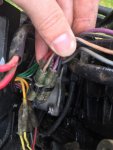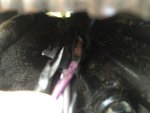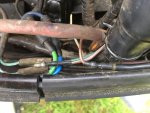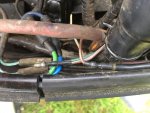scout-j-m
Chief Petty Officer
- Joined
- Jul 31, 2009
- Messages
- 636
This post is in regards to my 1994 70HP Force.
I was doing some voltage and resistance testing on my ignition system over the weekend. While doing so, I noticed that the wiring harness butt connectors had two missing wires on the ignition/motor side. I'm not sure if it is clear to everyone in the picture but the wires with nothing plugged into their butt connectors are the purple one and tan/blue. The other connections are all there. Those wires include the gray tach wire from the rectifier, the red wire from the rectifier, the black/yellow stop switch wire, and two more thicker gauged red wires which go to and from the fuse above the coils.
Can anyone tell me what these missing wires are for and are they for something important. I couldn't find any mention of them in my Clymer manual wiring diagrams. Not sure if it matters or not but my motor has the thunderbolt ignition system.

While hunting around for any unplugged wires, I found this brown/white wire also missing his female plug end. I know the green and blue wires seen in the picture are tilt/trim wires and the solid brown wire is the overheat buzzer. So I am stumped on this wire as well and would appreciate any help.

Finally, I just wanted to share this last picture. It is the wiring coming from the trigger directly below the flywheel. Having not yet pulled the flywheel to look at it in more detail and repair, it appears as if the purple wire (for cylinder 3 I believe) is bare and may almost be worn completely through. Also appears another wire or two may have been spliced together before by a previous owner. I plan to pull the flywheel this week and repair this and inspect everything under there since I have yet to pull the flywheel in the 6 or 7 years I have owned the boat.

I was doing some voltage and resistance testing on my ignition system over the weekend. While doing so, I noticed that the wiring harness butt connectors had two missing wires on the ignition/motor side. I'm not sure if it is clear to everyone in the picture but the wires with nothing plugged into their butt connectors are the purple one and tan/blue. The other connections are all there. Those wires include the gray tach wire from the rectifier, the red wire from the rectifier, the black/yellow stop switch wire, and two more thicker gauged red wires which go to and from the fuse above the coils.
Can anyone tell me what these missing wires are for and are they for something important. I couldn't find any mention of them in my Clymer manual wiring diagrams. Not sure if it matters or not but my motor has the thunderbolt ignition system.

While hunting around for any unplugged wires, I found this brown/white wire also missing his female plug end. I know the green and blue wires seen in the picture are tilt/trim wires and the solid brown wire is the overheat buzzer. So I am stumped on this wire as well and would appreciate any help.

Finally, I just wanted to share this last picture. It is the wiring coming from the trigger directly below the flywheel. Having not yet pulled the flywheel to look at it in more detail and repair, it appears as if the purple wire (for cylinder 3 I believe) is bare and may almost be worn completely through. Also appears another wire or two may have been spliced together before by a previous owner. I plan to pull the flywheel this week and repair this and inspect everything under there since I have yet to pull the flywheel in the 6 or 7 years I have owned the boat.






















